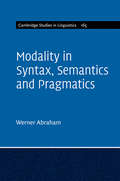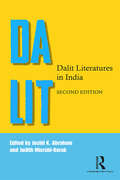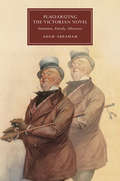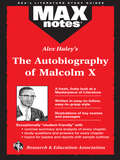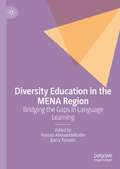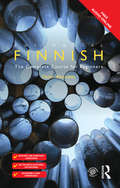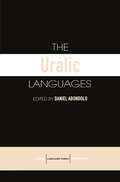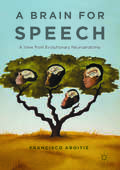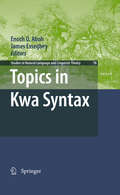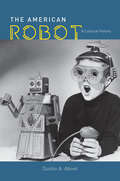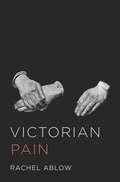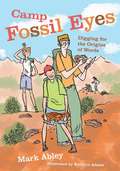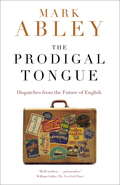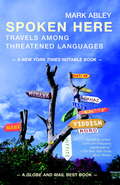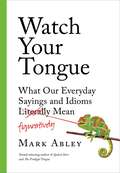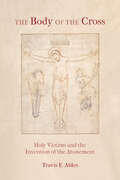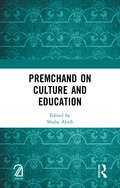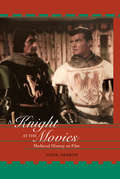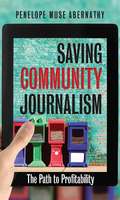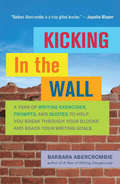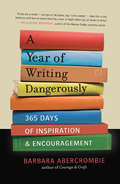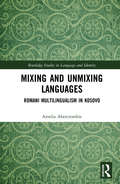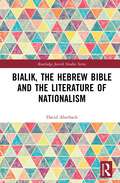- Table View
- List View
Modality in Syntax, Semantics and Pragmatics (Cambridge Studies in Linguistics #165)
by Werner AbrahamWhat do we mean when we say things like 'If only we knew what he was up to!' Clearly this is more than just a message, or a question to our addressee. We are expressing simultaneously that we don't know, and also that we wish to know. Several modes of encoding contribute to such modalities of expression: word order, subordinating subjunctions, sentences that are subordinated but nevertheless occur autonomously, and attitudinal discourse adverbs which, far beyond lexical adverbials of modality, allow the speaker and the listener to presuppose full agreement, partial agreement under presupposed conditions, or negotiation of common ground. This state of the art survey proposes a new model of modality, drawing on data from a variety of Germanic and Slavic languages to find out what is cross-linguistically universal about modality, and to argue that it is a constitutive part of human cognition.
Dalit Literatures in India
by Joshil K. Abraham Judith Misrahi-BarakThis book breaks new ground in the study of Dalit literature, including in its corpus a range of genres such as novels, autobiographies, pamphlets, poetry, short stories and graphic novels. With contributions from major scholars in the field, alongside budding ones, the book critically examines Dalit literary production and theory. It also initiates a dialogue between Dalit writing and Western literary theory. This second edition includes a new Introduction which takes stock of developments since 2015. It discusses how Dalit writing has come to play a major role in asserting marginal identities in contemporary Indian politics while moving towards establishing a more radical voice of dissent and protest. Lucid, accessible yet rigorous in its analysis, this book will be indispensable for scholars and researchers of Dalit studies, social exclusion studies, Indian writing, literature and literary theory, politics, sociology, social anthropology and cultural studies.
Plagiarizing the Victorian Novel: Imitation, Parody, Aftertext (Cambridge Studies in Nineteenth-Century Literature and Culture #118)
by Adam AbrahamHow can we tell plagiarism from an allusion? How does imitation differ from parody? Where is the line between copyright infringement and homage? Questions of intellectual property have been vexed long before our own age of online piracy. In Victorian Britain, enterprising authors tested the limits of literary ownership by generating plagiaristic publications based on leading writers of the day. Adam Abraham illuminates these issues by examining imitations of three novelists: Charles Dickens, Edward Bulwer-Lytton, and George Eliot. Readers of Oliver Twist may be surprised to learn about Oliver Twiss, a penny serial that usurped Dickens's characters. Such imitative publications capture the essence of their sources; the caricature, although crude, is necessarily clear. By reading works that emulate three nineteenth-century writers, this innovative study enlarges our sense of what literary knowledge looks like: to know a particular author means to know the sometimes bad imitations that the author inspired.
The Autobiography of Malcolm X as told to Alex Haley (Maxnotes Literature Guides)
by Anita AboulafiaREA's MAXnotes for Alex Haley's The Autobiography of Malcolm X MAXnotes offer a fresh look at masterpieces of literature, presented in a lively and interesting fashion. Written by literary experts who currently teach the subject, MAXnotes will enhance your understanding and enjoyment of the work. MAXnotes are designed to stimulate independent thought about the literary work by raising various issues and thought-provoking ideas and questions. MAXnotes cover the essentials of what one should know about each work, including an overall summary, character lists, an explanation and discussion of the plot, the work's historical context, illustrations to convey the mood of the work, and a biography of the author. Each chapter is individually summarized and analyzed, and has study questions and answers.
Diversity Education in the MENA Region: Bridging the Gaps in Language Learning
by Hassan Abouabdelkader Barry TomalinThis book outlines a landscape of diversity education in the MENA region and its repercussions on learners' abilities, outcomes, and prospects. It addresses the concerns of language educators, curriculum designers, language education researchers, students and trainers. Theoretically, the issues of diversity, inclusion and equity share common principles and insights; yet they are not conceived of in this book as interchangeable. These subtle distinctions, as delineated in this book, show that they are complementary and include the principles of quality education which leverage human rights, sustainability and promotion of the human capital. What makes this book distinctive is that it reconsiders the existing pedagogical trends in terms of the current social upheavals, and with reference to the principles of development and progress needed in twenty-first century education.
Colloquial Finnish: The Complete Course for Beginners (Colloquial Ser.)
by Daniel AbondoloColloquial Finnish provides a step-by-step course in Finnish as it is written and spoken today. Combining a user-friendly approach with a thorough treatment of the language, it equips learners with the essential skills needed to communicate confidently and effectively in Finnish in a broad range of situations. No prior knowledge of the language is required. Key features include: progressive coverage of speaking, listening, reading and writing skills structured, jargon-free explanations of grammar an extensive range of focused and stimulating exercises realistic and entertaining dialogues covering a broad variety of scenarios useful vocabulary lists throughout the text additional resources available at the back of the book, including a full answer key, a grammar summary and bilingual glossaries Balanced, comprehensive and rewarding, Colloquial Finnish will be an indispensable resource both for independent learners and students taking courses in Finnish. Audio material to accompany the course is available to download freely in MP3 format from www.routledge.com/cw/colloquials. Recorded by native speakers, the audio material features the dialogues and texts from the book and will help develop your listening and pronunciation skills.
The Uralic Languages (Routledge Language Family Series)
by Daniel AbondoloThis book provides a unique, up-to-date survey of individual Uralic languages and sub-groupings from Finnish to Selkup.Spoken by more than 25 million native speakers, the Uralic languages have important cultural and social significance in Northern and Eastern Europe, as well as in immigrant communitites throughout Europe and North America. The introductory chapter gives an overview of the Uralic language family and is followed by 18 chapter-length descriptions of each language or sub-grouping, giving an analysis of their history and development as well as focusing on their linguistic structures.Written by internationally recognised experts and based on the most recent scholarship available, the volume covers major languages - including the official national languages of Estonia, Finland and Hungary - and rarely-covered languages such as Mordva, Nganasan and Khanty. The 18 language chapters are similarly-structured, designed for comparative study and cover phonology, morphology, syntax and lexicon. Those on individual languages also have sample text where available. Each chapter includes numerous tables to support and illustrate the text and bibliographies of the major references for each language to aid further study. The volume is comprehensively indexed.This book will be invaluable to language students, experts requiring concise but thorough information on related languages and anyone working in historical, typological and comparative linguistics.
A Brain for Speech: A View from Evolutionary Neuroanatomy
by Francisco AboitizThis book discusses evolution of the human brain, the origin of speech and language. It covers past and present perspectives on the contentious issue of the acquisition of the language capacity. Divided into two parts, this insightful work covers several characteristics of the human brain including the language-specific network, the size of the human brain, its lateralization of functions and interhemispheric integration, in particular the phonological loop. Aboitiz argues that it is the phonological loop that allowed us to increase our vocal memory capacity and to generate a shared semantic space that gave rise to modern language. The second part examines the neuroanatomy of the monkey brain, vocal learning birds like parrots, emergent evidence of vocal learning capacities in mammals, mirror neurons, and the ecological and social context in which speech evolved in our early ancestors. This book's interdisciplinary topic will appeal to scholars of psychology, neuroscience, linguistics, biology and history.
Cambridge Approaches to Language Contact: The Emergence of Hybrid Grammars
by Enoch Oladé AbohChildren are extremely gifted in acquiring their native languages, but languages nevertheless change over time. Why does this paradox exist? In this study of creole languages, Enoch Aboh addresses this question, arguing that language acquisition requires contact between different linguistic sub-systems that feed into the hybrid grammars that learners develop. There is no qualitative difference between a child learning their language in a multilingual environment and a child raised in a monolingual environment. In both situations, children learn to master multiple linguistic sub-systems that are in contact and may be combined to produce new variants. These new variants are part of the inputs for subsequent learners. Contributing to the debate on language acquisition and change, Aboh shows that language learning is always imperfect: learners' motivation is not to replicate the target language faithfully but to develop a system close enough to the target that guarantees successful communication and group membership.
Topics in Kwa Syntax
by Enoch O. Aboh James EssegbeyThis volume demonstrates that Kwa languages offer a very rich empirical domain for linguistic theorizing, as experts who are mostly native speakers present empirical data and show its theoretical relevance to comparative linguistics and comparative syntax.
Too Many Rabbit Holes
by Marcie Aboff Jin ChiuThe fun and excitement of English and Language Arts learning continues in Grade 2 of Reading Street. This comprehensive and dynamic curriculum for homeschooling is geared toward young children who have some foundational English and Language Arts knowledge and are ready to strengthen their skills. Comprised of engaging activities, challenging content and weekly quizzes, Reading Street: Grade 2 is the next step in your child's path toward becoming a lifelong learner and reader. As with all Reading Street products, the Grade 2 system is formatted to help students meet certain age-appropriate goals. After completing this English and Language Arts homeschool program, your child should be able to: Read and comprehend two-syllable words. Identify common prefixes (such as pre-, un-, or re-) and suffixes (such as -able, -ad and -er). Correct mistakes made when reading out loud. Read books with two or more chapters. Understand the structure of stores (i. e. beginning, middle and end). Start selecting reading materials based on his/her own interests. Identify the "who," "what," "when," "where," "why" and "how" of the text. While the goals of second Grade English and Language Arts are numerous, Reading Street will help you craft engrossing lessons. Your child will garner important English and Language Arts skills while completing a workbook, reading stories and poems, and taking assessments. Planning these lessons will be easier than ever, as all Reading Street systems are broken down into weekly Big Ideas. All the work your child does on a given week is formulated around that single concept for an organized and challenging curriculum. With six easy-to-follow units, Reading Street: Grade 2 is the perfect tool for homeschooling parents. Your child will enjoy the reading selections and activities, and you'll love to see your student growing into a knowledgeable individual. We're confident that this product is the right one for you. For more information on the specific materials found in Grade 2 of Reading Street, check out the Features and Benefits page.
The American Robot: A Cultural History
by Dustin A. AbnetAlthough they entered the world as pure science fiction, robots are now very much a fact of everyday life. Whether a space-age cyborg, a chess-playing automaton, or simply the smartphone in our pocket, robots have long been a symbol of the fraught and fearful relationship between ourselves and our creations. Though we tend to think of them as products of twentieth-century technology—the word “robot” itself dates to only 1921—as a concept, they have colored US society and culture for far longer, as Dustin A. Abnet shows to dazzling effect in The American Robot. In tracing the history of the idea of robots in US culture, Abnet draws on intellectual history, religion, literature, film, and television. He explores how robots and their many kin have not only conceptually connected but literally embodied some of the most critical questions in modern culture. He also investigates how the discourse around robots has reinforced social and economic inequalities, as well as fantasies of mass domination—chilling thoughts that the recent increase in job automation has done little to quell. The American Robot argues that the deep history of robots has abetted both the literal replacement of humans by machines and the figurative transformation of humans into machines, connecting advances in technology and capitalism to individual and societal change. Look beneath the fears that fracture our society, Abnet tells us, and you’re likely to find a robot lurking there.
Victorian Pain
by Rachel AblowThe nineteenth century introduced developments in science and medicine that made the eradication of pain conceivable for the first time. This new understanding of pain brought with it a complex set of moral and philosophical dilemmas. If pain serves no obvious purpose, how do we reconcile its existence with a well-ordered universe? Examining how writers of the day engaged with such questions, Victorian Pain offers a compelling new literary and philosophical history of modern pain.Rachel Ablow provides close readings of novelists Charlotte Brontë and Thomas Hardy and political and natural philosophers John Stuart Mill, Harriet Martineau, and Charles Darwin, as well as a variety of medical, scientific, and popular writers of the Victorian age. She explores how discussions of pain served as investigations into the status of persons and the nature and parameters of social life. No longer conceivable as divine trial or punishment, pain in the nineteenth century came to seem instead like a historical accident suggesting little or nothing about the individual who suffers.A landmark study of Victorian literature and the history of pain, Victorian Pain shows how these writers came to see pain as a social as well as a personal problem. Rather than simply self-evident to the sufferer and unknowable to anyone else, pain was also understood to be produced between persons—and even, perhaps, by the fictions they read.
Camp Fossil Eyes: Digging for the Origins of Words
by Mark AbleyIn this fanciful book about etymology, 15-year-old Jill Boswell and her 13-year-old brother, Alex, are sent to summer camp in a bizarre badlands region -- the only place in the world where words are fossilized in rock.
The Prodigal Tongue
by Mark AbleyThe Prodigal Tongue takes a look at the wild, wacky and sometimes baffling road our language-English and others-is taking in its evolution. Where in the world will it end up?!Mark Abley, author of Spoken Here, has created an entertaining and informative exploration of the way that languages-English, Japanese, French, Arabic and other major tongues-are likely to transform and be transformed by their speakers during the twenty-first century. Grammar and vocabulary are just the beginning; more importantly, this book is about people. In places like Los Angeles, Tokyo, Singapore and Oxford, Abley encounters hip-hop performers and dictionary makers, bloggers and translators, novelists and therapists. He talks to a married couple who were passionately corresponding online before they met in "meatspace." And he listens to teenagers, puzzling out the words they coin in chatrooms and virtual worlds. Everywhere he goes, he asks what the future is likely to hold for the ways we communicate. Abley balances a traditional concern for honesty and accuracy in language with an untraditional delight in newly minted expressions. Lively, evocative, passionate and playful, this is a book for everyone who cherishes the words we use.From the Hardcover edition.
Spoken Here
by Mark AbleyWhether on the other side of the world or in our own backyard, languages everywhere are fading into oblivion. Mark Abley explores what the human family stands to lose -- and explains why some endangered languages continue to thrive.Within the next couple of generations, most of the world's 6000 languages will vanish, due mainly to the unstoppable tide of English. With an open mind and a well-worn passport, award-winning journalist and poet Mark Abley tells entertaining and vital stories about why languages matter. From Oklahoma to Provence, aboriginal Australia to Baffin Island, the cultures are radically different, but the problems of shrinking linguistic and cultural richness are painfully similar. Abley's investigation provides a stunning glimpse of the beauty and intricacies of languages like Yiddish and Yuchi, Mohawk and Manx, Inuktitut and Provençal. More importantly, it offers a sympathetic and memorable portrait of the people who still speak languages under threat.When a language dies out, gone too are stories that have been told for centuries, unique ways of seeing the world, and perhaps even ways of solving problems both large and small. Abley believes we must see languages as abundant sources of richness, wonder and usefulness. And he shows that hope still exists: that the determination of even one person can revive a whole language and its culture, in the process creating something new, changing and alive -- exactly what languages do best.From the Trade Paperback edition.
Watch Your Tongue: What Our Everyday Sayings and Idioms Figuratively Mean
by Mark AbleyPhrases, idioms, and clichés—why do we say the things we say? Watch Your Tongue explores weird and wonderful everyday sayings and what they reveal about us.Do you ever wonder why you shouldn’t have a cow but you should seize a bull by its horns? Who has the better reputation in language—cats or dogs? Do you sometimes feel that our speech is all smoke and mirrors or that our expressions simply make no sense? In Watch Your Tongue, award-winning author Mark Abley explores the phrases, idioms, and clichés of our everyday language. With wit and subtle wisdom, he unravels the mysteries of these expressions, illuminating the history, tradition and stories behind everything we say. Pulling examples from Shakespeare’s plays to sports team names, ancient Rome to Twitter, Abley shares samples and anecdotes of the eccentric ways that we play with, parse, and pattern language. Why do so many companies use fruit for their brand names? What do politicians mean when they say they’re going to “drain the swamp”? Why does English use chickens to signify cowardice? Abley dives into the history and psychology behind these examples and countless others, unpacking their significance (and sheer absurdity) to show how our language developed, where it is headed, and what we can learn about ourselves from it. Whimsically illustrated, easily browsable, and full of catchy sidebars, Watch Your Tongue celebrates how we amuse ourselves with words and what our sayings reveal about the way we see the world.
The Body of the Cross: Holy Victims and the Invention of the Atonement
by Travis E. AblesThe Body of the Cross is a study of holy victims in Western Christian history and how the uses of their bodies in Christian thought led to the idea of the cross as a substitutionary sacrifice. Since its first centuries, Christianity has traded on the suffering of victims—martyrs, mystics, and heretics—as substitutes for the Christian social body. These victims secured holiness, either by their own sacred power or by their reprobation and rejection. Just as their bodies were mediated in eucharistic, social, and Christological ways, so too did the flesh of Jesus Christ become one of those holy substitutes. But it was only late in Western history that he took on the function of the exemplary victim.In tracing the story of this embodied development, The Body of the Cross gives special attention to popular spirituality, religious dissent, and the writing of women throughout Christian history. It examines the symbol of the cross as it functions in key moments throughout this history, including the parting of the ways of Judaism and Christianity, the gnostic debates, martyr traditions, and medieval affective devotion and heresy. Finally, in a Reformation era haunted by divine wrath, these themes concentrated in the unique concept that Jesus Christ died on the cross to absorb divine punishment for sin: a holy body and a rejected body in one.
Premchand on Culture and Education
by Shuby AbidiPremchand on Culture and Education is a select collection of Premchand's journalistic articles, essays, and editorials, in English translation, written in journals like Madhuri, Hans and Jagran from 1928 to 1936. Indian society then witnessed an extemely perilous phase with British imperialism, capitalism, and aggressive nationalism distracting indians from the path of honesty, equality, and brotherhood. The present collection of Premchand's non-fiction prose is an amalagamation of his impressions of, and responses to, the upheavals taking place in the politically and socially charged decade of the 1930s of the 20th century. Like a torchbearer, Premchand educated and guided public opinion on a wide range of issues such as education, culture, communalism, language, arts, and the Gurukul system of education, famous universities, broadcasting, and cinema. Nearly all the articles/essays/editorials were written to combat the topical crisis, but the nature of the articles and the solutions provided have a bearing even today. Just as non-fiction is called the genre of the future, this collection of Premchand's non-fiction prose will be conducive for posterity and will facilitate fresh avenues of research on Premchand. Please note: Taylor & Francis does not sell or distribute the Hardback in India, Pakistan, Nepal, Bhutan, Bangladesh and Sri Lanka.
A Knight at the Movies: Medieval History on Film
by John AberthImagining the Middle Ages is an unprecedented examination of the historical content of films depicting the medieval period from the 11th to the 15th centuries. Historians increasingly feel the need to weigh in on popular depictions of the past, since so much of the public's knowledge of history comes from popular mediums. Aberth dissects how each film interpreted the period, offering estimations of the historical accuracy of the works and demonstrating how they project their own contemporary era's obsessions and fears onto the past.
Saving Community Journalism
by Penelope Muse AbernathyAmerica's community newspapers have entered an age of disruption. Towns and cities continue to need the journalism and advertising so essential to nurturing local identity and connection among citizens. But as the business of newspaper publishing collides with the digital revolution, and as technology redefines consumer habits and the very notion of community, how can newspapers survive and thrive? In Saving Community Journalism, veteran media executive Penelope Muse Abernathy draws on cutting-edge research and analysis to reveal pathways to transformation and long-term profitability. Offering practical guidance for editors and publishers, Abernathy shows how newspapers can build community online and identify new opportunities to generate revenue. Examining experiences at a wide variety of community papers--from a 7,000-circulation weekly in West Virginia to a 50,000-circulation daily in California and a 150,000-circulation Spanish-language weekly in the heart of Chicago--Saving Community Journalism is designed to help journalists and media-industry managers create and implement new strategies that will allow them to prosper in the twenty-first century. Abernathy's findings will interest everyone with a stake in the health and survival of local media.
Kicking In the Wall
by Barbara AbercrombieWhen Patti Smith was plagued with writer's block -- "scattered and stymied, surrounded by unfinished songs and abandoned poems" -- playwright Sam Shepard advised her, "When you hit a wall, just kick it in." In these pages, Abercrombie shows readers how to do just that. Like a workout with a top trainer, her writing exercises warm up, stretch, and build creative muscle. Quotes from famous writers inspire each day's exercise. Though Abercrombie says readers need only commit five minutes to each exercise, she writes, "I've seen novels, memoirs, and many essays get started" in those five minutes, "and a lot ended up being published." Her playful, powerful method is ideal -- maybe even essential -- fuel for writers trying to get off the starting block, persevere through challenges, and cross their personal creativity finish lines.
A Year of Writing Dangerously
by Barbara AbercrombieIn this collection of anecdotes, lessons, quotes, and prompts, author and writing teacher Barbara Abercrombie provides a delightfully varied cornucopia of inspiration --nuts-and-bolts solutions, hand-holding commiseration, and epiphany-fueling insights from fellow writers, including Nobel and Pulitzer Prize winners and Abercrombie's students who have gone from paralyzed to published.
Mixing and Unmixing Languages: Romani Multilingualism in Kosovo (Routledge Studies in Language and Identity)
by Amelia AbercrombieMixing and Unmixing Languages uses the politics and practices of language to understand social hierarchies and social change in a post-conflict and post-socialist context. The book focuses on Roma in Prizren, Kosovo, where the author conducted long-term ethnographic fieldwork, using language learning as a central method. Shifts in language practices among this highly multilingual group have reflected the demise of Yugoslav socialism, the rise of ethno-nationalist politics and conflict, and the post-war reversal of power relations in Kosovo. Roma in Prizren nostalgically narrate a past of cosmopolitanism and employment in contrast to the present. Their position today is complex: while they stress their relative integration, this position is fragile in the face of nationalist politics and imported neoliberal economic policies. Within this context, Roma NGO workers have found an economic niche working on projects to protect multiculturalism and minorities, funded by international aid agencies, centred on Romani language. This book discusses the historical trajectory and current configurations of a Romani organisation in the town, the standardisation of Romani and the hierarchical organisation of linguistic forms and language learning, the self-representation of Roma and the ‘gypsy’ image through Romani-language drama, and attitudes to purism, mixing and cosmopolitanism. Mixing and Unmixing Languages is suitable for academics and students in the areas of linguistic anthropology and linguistic ethnography, Romani studies, South-East European studies and sociolinguistics.
Bialik, the Hebrew Bible and the Literature of Nationalism (Routledge Jewish Studies Series)
by David AberbachThis book explores the life and poetry of Chaim Nachman Bialik (1873–1934) in the context of European national literature between the French Revolution and World War I, showing how he helped create a modern Hebrew national culture, spurring the revival of Hebrew as a spoken language. The author begins with Bialik’s background in the Tsarist Empire, contextualizing Jewish powerlessness in Eastern Europe in the late nineteenth century. As European anti-Semitism grew, Bialik emerged at the vanguard of a modern Hebrew national movement, building on ancient biblical and rabbinic tradition and speaking to Jewish concerns in neo-prophetic poems, love poems, poems for children, and folk poems. This book makes accessible a broad but representative selection of Bialik’s poetry in translation. Alongside this, a variety of national poets are considered from across Europe, including Solomos in Greece, Mickiewicz in Poland, Shevchenko in Ukraine, Njegoš in Serbia, Petőfi in Hungary, and Yeats in Ireland. Aberbach argues that Bialik as Jewish national poet cannot be understood except in the dual context of ancient Jewish nationalism and modern European nationalism, both political and cultural. Written in clear and accessible prose, this book will interest those studying modern European nationalism, Hebrew literature, Jewish history, and anti-Semitism.
